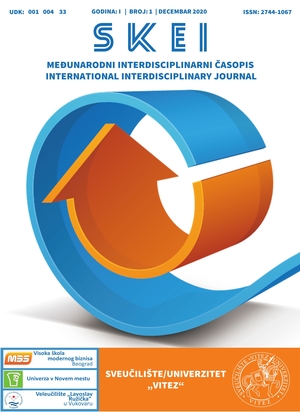UČESTALOST RAĐANJA I RANI NEONATALNI PERIOD HIPERTROFIČNE NOVOROĐENČADI
BIRTH FREQUENCY AND EARLY NEONATAL PERIOD HYPERTROPHIC NEWBORNS
Author(s): Indira AbdulovićSubject(s): Health and medicine and law
Published by: Sveučilište/Univerzitet "VITEZ"
Keywords: hypertrophic newborns; neonatal period;
Summary/Abstract: Retrospective studies which were carried out at the Travnik Cantonal Hospital within the period from 1 January 2018 to 31 December 2020 had tested the frequency of giving birth to hypertrophic newborns in JU Hospital Travnik in relation to characteristics of a mother and in relation to the frequency of perinatal complications. Within studies there were included live newborns with birth weight of 4000 grams and more; of both sexes in single pregnancies and without visible anomalies ( n= 544 ). Control Group was consisted of a time eutrophic newborns who were born in the same period, who were of both sexes and with birth weight of 3500 to 3999 grams (n=1035). In accordance with the collected data, there were 3215 live newborns, out of whom 544/3215 newborns birth weighted 4000 grams and more, with the frequency of 16,9%. In relation to the Control Group of 1035/3215 (32,2%) newborns with the birth weight of 3500 do 3999 grams, the difference is statistically significant (X2 = 432,0; P< 0,0001.). The highest incidence of giving birth to hypertrophic newborns was in municipalities of Travnik, Novi Travnik, Vitez and Gornji Vakuf, and statistically significant difference in relation to the Control Group was in municipalities of Travnik, Gornji Vakuf, and Vitez (P< 0,0001). Hypertrophic newborns were males more often (X2 =14,32 P=0,0002), with the average gestation age of 39,06 +/- 2 weeks of gestation, while Control Group was of the average gestation age of 38,83 +/- 2 weeks (Z=5,750; P< 0,0001). 35,14% mothers lived in the urban area during pregnancy and the rest of 64,86% lived in the rural area (P=0,0206). Lifetime of mothers who gave birth to hypertrophic newborns was in a range of 16 to 46, with the average lifetime of 31,3+/- 2 and it differentiated in relation to the Control Group (P=0,031). Perinatal complications emerged more than in the Control Group and the possibilities for its emergence were 5,45 times higher than in the Control Group of newborns. Statistically significant fact is that hypoglycaemia, brachial plexus paresis and fractures of clavicles occurred more frequently. Best perinatal outcome hypertrofic newborns could be achieved within optimal conditions for labour and early neonatal care with the presence of experienced neonatologist with appropriate technology and pharmacology support.
Journal: Skei - međunarodni interdisciplinarni časopis
- Issue Year: 5/2024
- Issue No: 1
- Page Range: 31-44
- Page Count: 14
- Language: Bosnian

